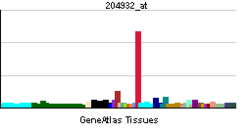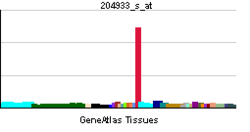Osteoprotegerin
| View/Edit Human | View/Edit Mouse |
Osteoprotegerin (OPG), also known as osteoclastogenesis inhibitory factor (OCIF), or tumor necrosis factor receptor superfamily member 11B (TNFRSF11B), is a protein that in humans is encoded by the TNFRSF11B gene.[3] Osteoprotegerin is a cytokine receptor, and a member of the tumor necrosis factor (TNF) receptor superfamily.
Structure
Osteoprotegerin is a basic glycoprotein comprising 401 amino acid residues arranged into 7 structural domains. It is found as either a 60-kDa monomer or 120-kDa dimer linked by disulfide bonds.[4]
Function
Osteoprotegerin is a decoy receptor for the receptor activator of nuclear factor kappa B ligand (RANKL). By binding RANKL, OPG prevents RANK-mediated nuclear factor kappa B (NF-κB) activation which is a central and rapid acting transcription factor for immune-related genes, and a key regulator of inflammation, innate immunity, and cell survival and differentiation.[5] Osteoprotegerin levels are influenced by voltage-dependent calcium channels Cav1.2.[6] OPG can reduce the production of osteoclasts by inhibiting the differentiation of osteoclast precursors (osteoclasts are related to monocytes/macrophages and are derived from granulocyte/macrophage-forming colony units (CFU-GM)) into osteoclasts and also regulates the resorption of osteoclasts in vitro and in vivo. OPG binding to RANKL on osteoblast/stromal cells, blocks the RANKL-RANK interaction between osteoblast/stromal cells and osteoclast precursors. This has the effect of inhibiting the differentiation of the osteoclast precursor into a mature osteoclast.
Regulation and therapeutic applications
Osteoprotegerin production is stimulated in vivo by the female sex hormone estrogen,[7] as well as the osteoporosis drug, strontium ranelate. Denosumab is a pharmacologic agent that in essence acts like osteoprotegerin as a decoy receptor for osteoblastic RANKL.
Recombinant human osteoprotegerin specifically acts on bone, increasing bone mineral density and bone volume. Space shuttle flight STS-108 in 2001 tested the effects of osteoprotegerin on mice in microgravity, finding that it did prevent increase in resorption and maintained mineralization.[8][9] Osteoprotegerin has been used experimentally to decrease bone resorption in women with postmenopausal osteoporosis and in patients with lytic bone metastases.
Clinical significance
Elevated OPG levels has been reported in heart diseases,[10] in placebo effect serum responses in IBS patients (doi:10.1111/j.1365-2982.2009.01440.x PMID 20028464) and in severe mental disorders.[11]
Mutations in TNFRSF11B are associated with osteoarthritis.[12]
It has been found that osteoprotegerin is expressed on mesenchymal stem cells, which mediates their suppressive effect on osteoclastogenesis.[13]
In recent years, it has been hypothesized that osteoprotegerin may be a link between bone and cardiovascular disease.[14][15] It has been particularly related to the increase in cardiovascular risk in patients suffering from diabetes [16][17]
References
- ↑ "Human PubMed Reference:".
- ↑ "Mouse PubMed Reference:".
- ↑ Simonet WS, Lacey DL, Dunstan CR, Kelley M, Chang MS, Lüthy R, Nguyen HQ, Wooden S, Bennett L, Boone T, Shimamoto G, DeRose M, Elliott R, Colombero A, Tan HL, Trail G, Sullivan J, Davy E, Bucay N, Renshaw-Gegg L, Hughes TM, Hill D, Pattison W, Campbell P, Sander S, Van G, Tarpley J, Derby P, Lee R, Boyle WJ (April 1997). "Osteoprotegerin: a novel secreted protein involved in the regulation of bone density". Cell. 89 (2): 309–19. doi:10.1016/S0092-8674(00)80209-3. PMID 9108485.
- ↑ Schoppet M, Preissner KT, Hofbauer LC (April 2002). "RANK ligand and osteoprotegerin: paracrine regulators of bone metabolism and vascular function". Arteriosclerosis, Thrombosis, and Vascular Biology. 22 (4): 549–53. doi:10.1161/01.ATV.0000012303.37971.DA. PMID 11950689.
- ↑ Krakauer T (2008). "Nuclear factor-kappaB: fine-tuning a central integrator of diverse biologic stimuli". International Reviews of Immunology. 27 (5): 286–92. doi:10.1080/08830180802317957. PMID 18853340.
- ↑ Bergh JJ, Xu Y, Farach-Carson MC (January 2004). "Osteoprotegerin expression and secretion are regulated by calcium influx through the L-type voltage-sensitive calcium channel". Endocrinology. 145 (1): 426–36. doi:10.1210/en.2003-0319. PMID 14525906.
- ↑ Khosla S (December 2001). "Minireview: the OPG/RANKL/RANK system". Endocrinology. 142 (12): 5050–5. doi:10.1210/en.142.12.5050. PMID 11713196.
- ↑ "Commercial Biomedical Testing Module: Effects of Osteoprotegerin on Bone Maintenance in Microgravity (CBTM)". U.S. National Aeronautics and Space Administration (NASA).
- ↑ Bateman TA, Countryman S (April 2002). "Osteoprotegerin and bone loss associated with spaceflight". Drug Discovery Today. 7 (8): 456–7. doi:10.1016/S1359-6446(02)02260-2. PMID 11965392.
- ↑ Venuraju SM, Yerramasu A, Corder R, Lahiri A (May 2010). "Osteoprotegerin as a predictor of coronary artery disease and cardiovascular mortality and morbidity". Journal of the American College of Cardiology. 55 (19): 2049–61. doi:10.1016/j.jacc.2010.03.013. PMID 20447527.
- ↑ Hope S, Melle I, Aukrust P, Agartz I, Lorentzen S, Steen NE, Djurovic S, Ueland T, Andreassen OA (September 2010). "Osteoprotegerin levels in patients with severe mental disorders". Journal of Psychiatry & Neuroscience. 35 (5): 304–10. doi:10.1503/jpn.090088. PMC 2928283
 . PMID 20569643.
. PMID 20569643. - ↑ Ramos YF, Bos SD, van der Breggen R, Kloppenburg M, Ye K, Lameijer EW, Nelissen RG, Slagboom PE, Meulenbelt I (September 2015). "A gain of function mutation in TNFRSF11B encoding osteoprotegerin causes osteoarthritis with chondrocalcinosis". Annals of the Rheumatic Diseases. 74 (9): 1756–62. doi:10.1136/annrheumdis-2013-205149. PMID 24743232.
- ↑ Takano T, Li YJ, Kukita A, Yamaza T, Ayukawa Y, Moriyama K, Uehara N, Nomiyama H, Koyano K, Kukita T (March 2014). "Mesenchymal stem cells markedly suppress inflammatory bone destruction in rats with adjuvant-induced arthritis". Laboratory Investigation; A Journal of Technical Methods and Pathology. 94 (3): 286–96. doi:10.1038/labinvest.2013.152. PMID 24395111.
- ↑ Blázquez-Medela AM, García-Ortiz L, Gómez-Marcos MA, Recio-Rodriguez JI, Sánchez-Rodríguez A, López-Novoa JM, Martínez-Salgado C (May 2012). "Osteoprotegerin is associated with cardiovascular risk in hypertension and/or diabetes". European Journal of Clinical Investigation. 42 (5): 548–56. doi:10.1111/j.1365-2362.2011.02619.x. PMID 22050177.
- ↑ Masser, RE; Lenhard, MJ (2014). "Osteoprotegerin is a Better Serum Biomarker of Coronary Artery Calcification Scores than Osteocalcin in Type 2 Diabetes.". Endocr pract. 6.
- ↑ Blázquez-Medela AM, García-Ortiz L, Gómez-Marcos MA, Recio-Rodriguez JI, Sánchez-Rodríguez A, López-Novoa JM, Martínez-Salgado C (May 2012). "Osteoprotegerin is associated with cardiovascular risk in hypertension and/or diabetes". European Journal of Clinical Investigation. 42 (5): 548–56. doi:10.1111/j.1365-2362.2011.02619.x. PMID 22050177.
- ↑ Blázquez-Medela AM, López-Novoa JM, Martínez-Salgado C (July 2011). "Osteoprotegerin and diabetes-associated pathologies". Current Molecular Medicine. 11 (5): 401–16. doi:10.2174/156652411795976565. PMID 21568931.
Further reading
- Blázquez-Medela AM, López-Novoa JM, Martínez-Salgado C (July 2011). "Osteoprotegerin and diabetes-associated pathologies". Current Molecular Medicine. 11 (5): 401–16. doi:10.2174/156652411795976565. PMID 21568931.
- Hofbauer LC, Neubauer A, Heufelder AE (August 2001). "Receptor activator of nuclear factor-kappaB ligand and osteoprotegerin: potential implications for the pathogenesis and treatment of malignant bone diseases". Cancer. 92 (3): 460–70. doi:10.1002/1097-0142(20010801)92:3<460::AID-CNCR1344>3.0.CO;2-D. PMID 11505389.
- Buckley KA, Fraser WD (November 2002). "Receptor activator for nuclear factor kappaB ligand and osteoprotegerin: regulators of bone physiology and immune responses/potential therapeutic agents and biochemical markers". Annals of Clinical Biochemistry. 39 (Pt 6): 551–6. doi:10.1258/000456302760413324. PMID 12564836.
- Kimberley FC, Screaton GR (October 2004). "Following a TRAIL: update on a ligand and its five receptors". Cell Research. 14 (5): 359–72. doi:10.1038/sj.cr.7290236. PMID 15538968.
- Collin-Osdoby P (November 2004). "Regulation of vascular calcification by osteoclast regulatory factors RANKL and osteoprotegerin". Circulation Research. 95 (11): 1046–57. doi:10.1161/01.RES.0000149165.99974.12. PMID 15564564.
- Whyte MP, Mumm S (September 2004). "Heritable disorders of the RANKL/OPG/RANK signaling pathway". Journal of Musculoskeletal & Neuronal Interactions. 4 (3): 254–67. PMID 15615493.
- Anandarajah AP, Schwarz EM (February 2006). "Anti-RANKL therapy for inflammatory bone disorders: Mechanisms and potential clinical applications". Journal of Cellular Biochemistry. 97 (2): 226–32. doi:10.1002/jcb.20674. PMID 16240334.
- Baud'huin M, Duplomb L, Ruiz Velasco C, Fortun Y, Heymann D, Padrines M (February 2007). "Key roles of the OPG-RANK-RANKL system in bone oncology". Expert Review of Anticancer Therapy. 7 (2): 221–32. doi:10.1586/14737140.7.2.221. PMID 17288531.
- Boyce BF, Xing L (2007). "Biology of RANK, RANKL, and osteoprotegerin". Arthritis Research & Therapy. 9 Suppl 1 (Suppl 1): S1. doi:10.1186/ar2165. PMC 1924516
 . PMID 17634140.
. PMID 17634140. - Maruyama K, Sugano S (January 1994). "Oligo-capping: a simple method to replace the cap structure of eukaryotic mRNAs with oligoribonucleotides". Gene. 138 (1-2): 171–4. doi:10.1016/0378-1119(94)90802-8. PMID 8125298.
- Tsuda E, Goto M, Mochizuki S, Yano K, Kobayashi F, Morinaga T, Higashio K (May 1997). "Isolation of a novel cytokine from human fibroblasts that specifically inhibits osteoclastogenesis". Biochemical and Biophysical Research Communications. 234 (1): 137–42. doi:10.1006/bbrc.1997.6603. PMID 9168977.
- Suzuki Y, Yoshitomo-Nakagawa K, Maruyama K, Suyama A, Sugano S (October 1997). "Construction and characterization of a full length-enriched and a 5'-end-enriched cDNA library". Gene. 200 (1-2): 149–56. doi:10.1016/S0378-1119(97)00411-3. PMID 9373149.
- Tan KB, Harrop J, Reddy M, Young P, Terrett J, Emery J, Moore G, Truneh A (December 1997). "Characterization of a novel TNF-like ligand and recently described TNF ligand and TNF receptor superfamily genes and their constitutive and inducible expression in hematopoietic and non-hematopoietic cells". Gene. 204 (1-2): 35–46. doi:10.1016/S0378-1119(97)00509-X. PMID 9434163.
- Yamaguchi K, Kinosaki M, Goto M, Kobayashi F, Tsuda E, Morinaga T, Higashio K (February 1998). "Characterization of structural domains of human osteoclastogenesis inhibitory factor". The Journal of Biological Chemistry. 273 (9): 5117–23. doi:10.1074/jbc.273.9.5117. PMID 9478964.
- Yasuda H, Shima N, Nakagawa N, Mochizuki SI, Yano K, Fujise N, Sato Y, Goto M, Yamaguchi K, Kuriyama M, Kanno T, Murakami A, Tsuda E, Morinaga T, Higashio K (March 1998). "Identity of osteoclastogenesis inhibitory factor (OCIF) and osteoprotegerin (OPG): a mechanism by which OPG/OCIF inhibits osteoclastogenesis in vitro". Endocrinology. 139 (3): 1329–37. doi:10.1210/en.139.3.1329. PMID 9492069.
- Yasuda H, Shima N, Nakagawa N, Yamaguchi K, Kinosaki M, Mochizuki S, Tomoyasu A, Yano K, Goto M, Murakami A, Tsuda E, Morinaga T, Higashio K, Udagawa N, Takahashi N, Suda T (March 1998). "Osteoclast differentiation factor is a ligand for osteoprotegerin/osteoclastogenesis-inhibitory factor and is identical to TRANCE/RANKL". Proceedings of the National Academy of Sciences of the United States of America. 95 (7): 3597–602. doi:10.1073/pnas.95.7.3597. PMC 19881
 . PMID 9520411.
. PMID 9520411. - Tomoyasu A, Goto M, Fujise N, Mochizuki S, Yasuda H, Morinaga T, Tsuda E, Higashio K (April 1998). "Characterization of monomeric and homodimeric forms of osteoclastogenesis inhibitory factor". Biochemical and Biophysical Research Communications. 245 (2): 382–7. doi:10.1006/bbrc.1998.8443. PMID 9571159.
- Bucay N, Sarosi I, Dunstan CR, Morony S, Tarpley J, Capparelli C, Scully S, Tan HL, Xu W, Lacey DL, Boyle WJ, Simonet WS (May 1998). "osteoprotegerin-deficient mice develop early onset osteoporosis and arterial calcification". Genes & Development. 12 (9): 1260–8. doi:10.1101/gad.12.9.1260. PMC 316769
 . PMID 9573043.
. PMID 9573043. - Emery JG, McDonnell P, Burke MB, Deen KC, Lyn S, Silverman C, Dul E, Appelbaum ER, Eichman C, DiPrinzio R, Dodds RA, James IE, Rosenberg M, Lee JC, Young PR (June 1998). "Osteoprotegerin is a receptor for the cytotoxic ligand TRAIL". The Journal of Biological Chemistry. 273 (23): 14363–7. doi:10.1074/jbc.273.23.14363. PMID 9603945.
- Morinaga T, Nakagawa N, Yasuda H, Tsuda E, Higashio K (June 1998). "Cloning and characterization of the gene encoding human osteoprotegerin/osteoclastogenesis-inhibitory factor". European Journal of Biochemistry / FEBS. 254 (3): 685–91. doi:10.1046/j.1432-1327.1998.2540685.x. PMID 9688283.
- Blázquez-Medela AM, López-Novoa JM, Martínez-Salgado C (July 2011). "Osteoprotegerin and diabetes-associated pathologies". Current Molecular Medicine. 11 (5): 401–16. doi:10.2174/156652411795976565. PMID 21568931.
External links
- Osteoprotegerin at the US National Library of Medicine Medical Subject Headings (MeSH)

